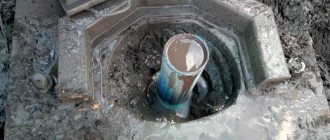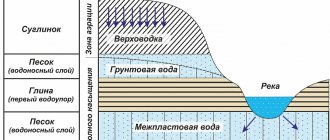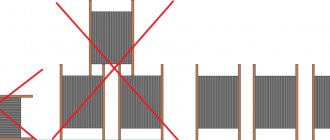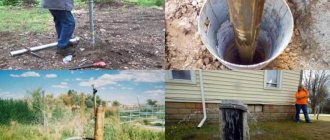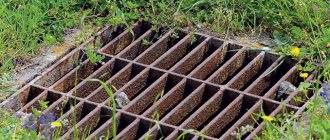Let's understand the terminology: what does the name mean?
There is hardly a person who has never heard of an artesian well and that this is one of the best water supply options. An artesian well is a circular opening drilled to reach aquifers with certain properties.
Some underground aquifers lie between impervious layers. Interstratal waters can be non-pressure and pressure; the latter are called artesian. The name comes from the historical region of Artois in northeastern France. Here, since the 12th century, for the first time in Europe, they learned to build gushing wells.
Artesian layers are located in certain geological structures (in depressions, bends, troughs). The depth at which artesian water lies depends on specific geological conditions. Aquifers are formed at different depths, from 100 to 1000 m; for domestic use, sources with a depth of no more than 150-200 m are most often developed.
Diagram of an artesian well Source strojdvor.ru
An artesian aquifer is composed of sedimentary rock: limestone, sand, dolomite or gravel. Water fills voids, cavities and cracks in loose material. The aquifer is enclosed between impermeable layers (usually clay), so the water in it is under pressure.
An artesian aquifer is composed of sedimentary rock: limestone, sand, dolomite or gravel. Water fills voids, cavities and cracks in loose material. The aquifer is enclosed between impermeable layers (usually clay), so the water in it is under pressure.
At what depth is artesian water
There are 6 aquifers on the territory of Moscow and the Moscow region.
These horizons are formed by limestone. Aquifers overlap each other. You can drill a source in any area, at any point. The source's feeding area can be located tens or hundreds of kilometers from the water intake site.
The Podolsko-Myachkovsky horizon covers almost the entire Moscow region, except for the southwestern regions. Depth: from 10 to 450 m. Static level of sources: 20-120 m. Flow rate from 3000 liters per hour.
The Kasimovsky horizon is at a level of 7-45 m. Due to its proximity to the surface, the water quality may be unsatisfactory. Flow rate from 3000 liters per hour.
The Kashira horizon also covers almost the entire Moscow region, except for some zones in the south. Depth: 10-40 m. Average flow rate of sources: 2000-3000 liters per hour.
The Gzhel-Assel horizon is present in the north of the Moscow region. It is located at a level from 2 to 190 m. The flow rate is also from 3000 liters per hour.
The Protvinsky horizon is present in the northeast of the region. It is found at a level from 9 to 150 m. The flow rate is 3000-5000 liters per hour.
The Aleksino-Tarussky horizon ranges from a few meters to 110-450 m. The flow rate is low: from 500 liters per hour.
Find out the depth of the well on your site!
Click on the button and order a consultation with an Aqualux+ manager.
Find out the depth
Figure 3: Aquifers of the Moscow region.
Water quality
An artesian well provides access to pressurized interlayer water, which is naturally isolated. Clay waterproof layers serve as natural filters, trapping any impurities. Thanks to reliable protection, the water does not mix with surface waters, has a constant chemical composition and high quality.
Often the water in the pressure limestone layer is additionally enriched with salts and microelements and becomes mineral. The content of ferrous impurities or salts may exceed standard values. In this case, the water is purified by filters to make it suitable for drinking.
Subtleties of geology Source moikolodets.ru
What is the service life?
The service life of an artesian well is influenced by the following factors:
- quality of work performed.
- chemical composition of soils.
- quality of the water raised.
- regular maintenance.
The maximum possible service life of an artesian source can reach up to 50 years, but when using a design with one casing pipe, the period ranges from 25 to 30 years.
In order for the well to last longer, you should ensure regular pumping, use water intensively and avoid long periods of downtime to prevent sludge from getting into the system.
Advantages and disadvantages of wells for limestone
This method of providing clean water has several important advantages :
- A durable source of high-quality drinking water with a long service life.
- Uninterrupted supply, independent of season or climate change.
- Interstratal pressure waters have a constant chemical composition, their quality does not suffer from precipitation or human activity.
- The volume of extracted water (from 5 to 20 cubic meters per hour) is enough to supply several farms. It is beneficial for neighbors to unite and lay a common water well.
Disadvantages are considered:
- The large depth of drilling with the use of heavy equipment is the main reason for the high cost.
- To supply water, equipment of increased power is required, which also increases the budget.
- Mineralized water negatively affects pipes and boilers, causing scale formation.
Always nearby Source ecoindustry.ru
- If the source is saturated with salts, it can lead to health problems. In this case, you cannot do without water purification filters.
- Sometimes, due to the unfortunate characteristics of the soil, drilling is delayed for weeks, and sometimes for months.
- It is necessary to obtain a license for an artesian source.
See also: Catalog of companies that specialize in the design and installation of water supply and sewerage
What does the cost consist of?
The total cost of turnkey well drilling is influenced by many factors, including:
- Fare.
- Type and used drilling technology.
- Materials for casing and pipes.
- Pumping to clean water.
- Project and passport with included source characteristics.
Equipping a well is not a cheap task and can take a lot of time. Therefore, it made sense to unite several farms and choose a site accessible to all participants.
Artesian well drilling technology
If you know what an artesian well is, it will be easier to understand the process of drilling it. This is done in two ways :
- Using a large drilling rig based on a truck (for example, GAZ-66 or ZIL-131).
- Using a portable drilling rig. It is chosen if large equipment cannot enter the drilling site.
In practice, several drilling methods are used. The most common is the rotational method with direct flushing; its share is about 90% of all drilling volumes. The process includes the following steps :
- The drilling machine destroys and erodes rock in the working area using specialized tools and drilling fluid. The waste is washed into a special pit.
Portable water drilling rig Source drillingrig.com
- As a result of the operation of the installation, generation is formed. Its diameter exceeds the diameter of the casing pipes by 40-50 mm.
- When the excavation reaches the aquifer, casing pipes are lowered (planted) into the well, connecting them into a column.
- When casing, pipes with threaded connections are used. They come in metal or plastic. Casing is needed for two reasons: it prevents the well from crumbling and prevents contamination by groundwater.
- A drill head with a smaller (30-50 mm) diameter is lowered into the prepared column. It opens the aquifer and flushes the well with clean water.
- The owner is invited to lift the drill rods to measure the depth of the well. Drill rods are hollow equipment that serves to transmit rotation and at the same time supply drilling fluid.
- The rest of the equipment, filters, and pump are being installed.
Heavy equipment Source puls-rf.ru
What kind of well is this?
An artesian well is an underground well created by drilling deep into an aquiferous limestone layer. The depth of the well varies depending on the area and terrain features, and can be from 30 to 250 m.
When the limestone layer is opened, it is possible to obtain clean water, which is naturally filtered at great depths. But there is a nuance - this water can be mineralized, including magnesium/calcium/iron/manganese salts. If the test confirms strong mineralization, it is necessary to take care of the water softening system.
Drilling parameters
In many cases, only an artesian well can provide a site with water; how many meters its depth will be is not an idle question, it largely determines the final cost of the work. The peculiarity of aquiferous limestones is that they occur unevenly.
Closer to the surface, at a depth of 20-40 m, non-pressure interstratal waters lie. The depth of pressure sources in the Russian Federation reaches 200-250 m. Before work begins, the depth of the well is estimated approximately; the exact number can be found out only after drilling.
There are several characteristics of an artesian well; except for the question
how many meters it will go deep, its diameter and the method of drilling are important. For industrial needs, a diameter of 219-325 mm is chosen, which depends on the productivity and depth, well and pump characteristics.
The diameter of the well for the private sector is determined by the parameters of popular domestic deep-well pumps. Their diameter rarely exceeds 102 mm, so a well with a pipe diameter of 127-159 mm is drilled for them.
Drilling near the house Source izion.pro
Manufacturers offer pumps with a smaller diameter, no more than 50-76 mm, which can be installed with pipes with a diameter of 76 mm or more. At first glance, this option seems profitable, as it allows you to save money. In fact, such devices are ineffective, and those that provide pumping in the required volume are prohibitively expensive. Also, do not forget that small-diameter wells, as a rule, cannot be repaired.
What documents are required and how are they prepared?
The documentation and process of drilling an industrial artesian well consists of the following points:
- Obtaining a license for the right to use water resources.
- Development of design documentation and its coordination with Rospotrebnadzor.
- Carrying out drilling operations with the construction of a production well according to the project.
- Carrying out a complex of geophysical studies of soil and laboratory analyzes of water quality.
- Registration of a passport for a well, taking into account the physical parameters of water resources.
- Registration of a well and assignment of a cadastral number to it.
- Installation of pumping equipment in a caisson, house, or separate room.
- Development of design documentation for the installation of a water intake unit.
- Carrying out installation work to assemble a unit for water consumption.
As for drilling individual wells, according to the law (Article 19 of the Russian Federation Law on Subsoil), owners of individual plots have the right of ownership to commonly occurring minerals, including water resources, if three conditions are met:
- The volume of water consumed does not exceed 100 cubic meters per day.
- Extracted water resources are used to meet their own needs and not for commercial use.
- The exploited water basin must be located above the aquifer used for the needs of centralized water supply.
Since water resources on an individual plot are not listed on the state balance sheet and are actually equated to land, to drill artesian wells on private territory, their owner does not require a permitting license or any further documentation, subject to the above three points.
Rice. 13 Well arrangement diagram with adapter
Features of operation
A free-flow sand well is designed for an average service life of 5-7, rarely more, years. Unlike a sand well, an artesian well with a depth of 100 m or more is characterized by a high degree of reliability. Sources from such depths have been exploited for 40-50 years. The service life depends on the depth and pressure of the aquifer being opened; The following options are possible :
- Wells drilled into an aquifer close to the surface operate for no more than 25-30 years. Shallow springs silt up and therefore require repair work every 7-10 years.
Cleaning from siltation Source global-bur.ru
- A free-flow well on limestone will last 20-30 years. The service life can be significantly extended if a two-pipe design is used.
- An artesian well for deep sand will work for 20-25 years, if you do not violate the operating rules.
Well life will be reduced if:
- Do not install a well filter when the aquifer rocks are mobile.
- Install a pump that exceeds the capacity of the aquifer. This may lead to filter failure.
- Violate the maximum water withdrawal limit.
Installation of a deep-well pump Source bitrix24.ru
Post-drilling service
We provide servicing of sources. Regular system maintenance is a condition for obtaining the warranty. We service systems installed by our specialists and representatives of other companies.
Procedure for servicing the system:
- Performance measurement: flow rate, static and dynamic level.
- Study of the operation of the pumping station.
- Checking the liquid: color, smell, transparency, taste.
- If necessary: flush the barrel.
- If necessary: repair or replacement of equipment.
Maintenance is carried out twice a year if there are permanent residents in the house. Or once every 9 months if the house is used as a summer house. The procedure takes several hours.
What does the cost depend on?
To drill a well for water from an artesian aquifer, on average it takes 5-7 days. The cost of an artesian well for limestone, carried out on a turnkey basis, exceeds the cost of a source from a shallow, non-confined sandy horizon.
The high cost is justified by long service life and gradual payback. The following reasons influence the final price :
- Due to the great depth, drilling is characterized by increased complexity; heavy drilling equipment is used.
- A deep source requires a larger mine diameter and more casing pipes. This increases the cost of drilling and payment for drilling work.
- Deep burial requires the use of high-quality materials that can last for decades.
- The estimate increases if there is a need for additional work. Thus, when casing a well, annular cementation is sometimes carried out.
PVC casing pipes Source o-trubah.ru
Average well depth in the Moscow region
You can try to determine what depth the artesian well will be on your site using the map. Our website has an interactive map that can help you determine the drilling depth for your area.
Depth by regions of the Moscow region (m):
>
| Average well depth | Drilling areas |
| 20-50 | Ozersky |
| 30-60 | Noginsky |
| 30-70 | Stupinsky |
| 30-80 | Chekhovsky, Ramensky, Domodedovo |
| 30-90 | Podolsky, Naro-Fominsky, Mozhaisky |
| 30-100 | Ruzsky |
| 30-120 | Klinsky, Istrinsky |
| 30-130 | Serpukhovskaya |
| 40-70 | Orekhovo-Zuevsky |
| 40-90 | Pavlovo-Posadsky |
| 40-100 | Egoryevsky |
| 40-120 | Lotoshinsky, Krasnogorsky, Voskresensky, Volokolamsky |
| 50-70 | Shchelkovsky |
| 50-220 | Dmitrovsky |
| 60-80 | Lyubertsy |
| 60-100 | Shakhovskoy, Lukhovitsky, Zaraisky |
| 60-120 | Odintsovsky, Mytishchisky, Kashirsky. |
| 70-100 | Pushkinsky |
| 70-120 | Kolomensky |
| 80-110 | Taldomsky |
| 80-140 | Shatursky, Leninsky |
| 80-200 | Solnechnogorsk |
| 100-220 | Sergiev Posadsky |
Briefly about the main thing
They learned to extract water from artesian formations many centuries ago. The method has become publicly available; it is used in places where aquifers lie in the desired geological structure, at a depth accessible to specialized drilling rigs.
Water from artesian sources flows uninterruptedly, is clean and has a constant chemical composition. Depending on the depth of the site, heavy equipment or a portable drilling rig is used for drilling. The exact depth can only be determined after raising the drill rods.
Wells with different depths have different service lives and are operated differently. Their cost is influenced by the volume and cost of drilling, the choice of materials, and the need for additional work.
Ratings 0
Types of designs
There are several design options for artesian springs. Their choice depends on:
- geology of the site;
- pump diameter;
- the amount of water required to use.
Depending on this, wells may have several options for arrangement.
Classic type
Here it is allowed to install one casing pipe, which at the same time acts as a production (water) pipe. The design allows the operation of the source provided there is sufficient pressure in the formation and the calcareous composition of the waterproof layer. In this case, the limestone should not contain clay or sand layers. That is why the classic design is also called a limestone well.
- The depth of the trunk can vary in the range of 55-260 m.
- The water comes in perfectly clean.
- The optimal casing diameter is 133 and 159 mm.
With double casing
A similar design is used when there is clay or sand in the limestone. The main metal, also known as casing, pipe descends to the limestone, blocking the entry of impurities into the liquid. The second pipe (production string) of smaller diameter with perforation and pump is lowered below the level of liquid entry into the system.
- The diameter of the casing pipe is 133 mm or 159 mm.
- The diameter of the internal production string is 117 mm or 133 mm.
Typically, the inner pipe is made of unplasticized polyvinyl chloride (uPVC).
Conductor design
It is a complicated classic version. The application is justified in the case of a wellbore passing through quicksand and other dangerous areas in the upper part of the soil.
The conductor is a durable cylinder (pipe) with a diameter significantly larger than the size of the casing. It provides barrel protection in the danger zone. When using caissons for arrangement, the jig is often made as a continuation of the walls of the caisson.
Telescopic design
At its core, it is a multi-layer well casing.
The need for such a design arises when there are dangerous areas at different depths. The well is set up as follows:
- first, a metal pipe of the largest size is lowered to the depth of the lowest level of the most buried dangerous area;
- then, inside the first pipe, up to the lime layer, the main casing, metal pipe is installed;
- after which a service pipe made of HDPE or uPVC is installed inside the main column.
The choice of well type when opening an artesian formation depends on the specific conditions and condition of the soil. It is made on the basis of geological survey data. It is important to take into account that insufficient protection of the mine shaft from quicksand and seam movements leads to the destruction of the casing and failure of the hydraulic structure.
Sequence of drilling work
Work on drilling artesian water carriers begins with digging a hole 150x150 cm in size and at least a meter deep.
Using wooden boards, you can simultaneously strengthen crumbling sandy soil from the surface layer. Thanks to the installation hole, the main drill is secured. Be sure to install a tripod above the surface of the drill. A mechanized or manual winch is attached to the top. A drill core is an effective option for drilling an artesian water well. This design is equipped with a convenient head, when moving it deeper, the mechanism is extended with rods secured with threaded connections. The cross-section of the submersible pump must correspond to the diameter of the drill rod and be no less than 0.5 cm less than the internal size of the casing tube. After fixing the assembled rod on the tripod, drilling work begins.
Rotary impact technology is most often used in the drilling process. In this case, the mechanism is lifted by a winch, and lowered by an acting force. Rotations of the column are made with a gas wrench, making corresponding marks on the drill string.
Drilling an artesian water well can be carried out independently or with the involvement of special organizations. The second option is more expensive, so if you have the necessary equipment and skills, you can do everything yourself.
Drilling work should be carried out using suitable techniques.
In this case, it is necessary to remove the drill column and replace the working tip. It is more effective to go through sandy soil with a spoon drill. During such work, one can observe the filling of the drill string with water-clay mass.
When approaching dense layers of the horizon, it is recommended to use the chiseling method, lifting up the loosened rock. The bailer will help when passing sandy quicksand.
The coil drill is effective for digging through clay layers in areas with adequate soil. Filling the structure with water helps facilitate passage deeper into the rock.
The pump method of digging a water carrier is also very popular. Its technology is based on the erosion of soil by water supplied under high pressure. The presence of excessive amounts of liquid in the excavated soil indicates an approaching aquifer. Drilling work is completed when the structure reaches impenetrable horizons.
After drilling work, it is imperative to install a filter on the artesian source, since the lower horizons are saturated with sand.
The filter device is mounted on the base of the water intake pipe. You can use both ready-made and homemade filter columns. In the second case, a perforated cylinder or fine mesh is used.
How do the main stages of drilling an artesian well occur in practice:
Aquifers
Before getting an answer to the burning question of how deep to drill a well, they understand the diversity and characteristics of aquifers. The layers that provide the supply of water for household needs are divided into 3 groups:
- The upper one is called perched water; its depth varies from 4 to 7 m. There is no stable water-resistant layer here, so water from the well is used mainly for irrigation and other technical needs. The liquid is often cloudy due to the presence of sand and other impurities.
- The second layer is located at a depth of 10 to 18 meters.
Typically, drinking water comes into the well from this formation. Note! After groundwater passes through the well filters, the water becomes much cleaner than that taken from a well. However, here too there is a risk of dangerous and harmful impurities. It especially increases during spring floods. Sometimes there is a smell of hydrogen sulfide. Water analysis for compliance with SES requirements, which is carried out by licensed laboratories, will help prevent poisoning. - Artesian waters are located on the third aquifer. The depth of its occurrence varies at around 25-40 meters. However, the indicator depends on the topography of the area and sometimes reaches 60 m. Artesian water is considered the most healthy and clean.
A visual diagram of the occurrence of aquifers is shown in the photo:
Drilling depth: how to determine
This value is determined after determining the structure of the aquifer. Since groundwater depth characteristics may vary in the same area, it is necessary to carry out several test drillings.
Another option for determining the depth of the aquifer is to analyze the vegetation - plant roots allow us to judge the layout of the soil layers.
In order to start drilling, you need to know the structure of the water layer.
Test work can be core work and refer to one of the proven methods for determining the depth of liquid. In this case, when a moistened sand layer appears, the process can be stopped: the channel is filled with water, then pumped out and thus the flow rate of the future well is determined.
If the obtained indicators meet the requirements of the site owner, then drilling is stopped and a well is installed. Otherwise, the well is developed further until the next aquifer is reached. When water is received, it must be collected for analysis to determine whether the source is suitable for drinking.
When carrying out the drilling process, it is necessary to remember that some types of wells are subject to mandatory registration. However, Abyssinian and sand wells can be used without permits.
Selection of equipment for a well - its types and types
It all depends on the type of soil on the site, the well itself, its depth and purpose - a large amount of additional equipment can be used. Let's look at the main types and types most often used when digging wells:
- hydraulic accumulator;
- two adapters: one for removing the pipe from the bypass column, and the second for sealing, if there is no caisson;
- pump and a set of parts for its installation - used to supply water;
- non-return valve - it lets water into a house or other building;
- the pressure gauge will show the pressure level in the pipes - an important point for the general control of the entire system;
- cable made of stainless steel with the same clamps;
- a sufficient number of tees for branching the water supply network;
- consumables - fasteners, sealant, electrodes.
On our website you can buy Aquario hydraulic accumulators and get a discount on its installation.
What are the stages of creating a well?
The whole process can be divided into the following stages:
Geological exploration . Work performed: determination of the depth of groundwater, condition, composition and freezing of the soil, pressure and productivity of the layer.
Drilling . Work performed: using the selected technology, a well is drilled and flushed.
Installation . Work performed: casing pipes and submersible equipment are installed.
Arrangement . Work performed: installation of a caisson, submersible pump, hydraulic accumulator, automation system, water pipeline distribution.
Decor . Work performed: external decorative design of the facility and the surrounding area.
These are general steps that can be changed based on the type of well and its development project.
After you have the project in your hands, you can apply for a license from the Ministry of Natural Resources, or rather, from its local branch. You should also have on hand: confirmation of ownership and registration documents for the land.
